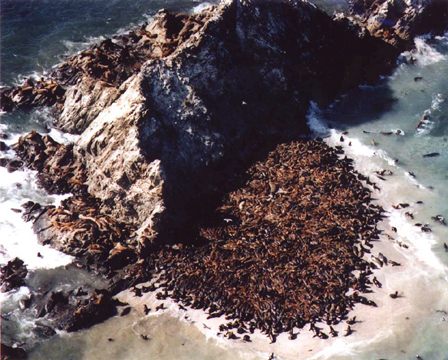
Revisiting the Botkin Salmon Study
Seals photographed on an island near the mouth of the Klamath River during a run of steelhead. There are several thousand seals shown in the picture, and each one was estimated to have killed at least 2-4 steelhead per day during the run (see Zybach and Ice 1997: 293).
Zybach, Bob and George Ice 1997. "Revisiting the Botkin Salmon Study," IN: Proceedings of the 1997 NCASI West Coast Regional Meeting, Special Report No. 97-13, National Council for Air and Stream Improvement (NCASI), Corvallis, Oregon: pp. 276-321. [HTML/JPG - PDF (24 mb.)].
This paper was presented by Bob Zybach in Portland, Oregon on September 25, 1997 at the annual West Coast Regional Meeting of the National Council for Air and Stream Improvement (NCASI). Meeting events occurred over a two day period and focused on: air quality management; environmental health topics; water quality management; pollution prevention; cluster rule implementation; and the role of forest management in salmon recovery. This paper represents one of twelve presentations given on the latter topic (see Table of Contents for a complete listing).
Here are the key points made in the NCASI report and presentation, as of 1997:
1. There is no reliable evidence that a decline in western Oregon salmon populations has occurred since implementation of the Oregon Forest Practices Act in 1972.
2. Western Oregon salmon stocks that have gone extinct or declined noticeably during the past 150 years can be accounted for largely by off-shore ocean conditions, seasonal and long-term variations in climate, the construction of dams and roads, and the development of commercial fisheries. Historical forestry practices have had little, if any, discernible effect on salmon stock extinctions or decimations.
3. Foregone income (leaving merchantable trees unharvested, etc.) and direct expenses (placing large trees into streams, etc.) that are paid for riparian "watershed enhancement" projects involving stream and streambank restructuring—in excess of legal requirements—will probably have little, if any, impact on adult salmon populations.
Anadromous Fishes of Western
Oregon. |
Spawned-out salmon: 1995 Natural History magazine
cover. |
The myth of the returning salmon: no strays. |
Freshwater predators. |
|
Figure 1. Botkin study area (p. 300). |
Figure 2. Oregon salmon ocean ranges (p. 301). |
Figure 3. Alaskan salmon harvests, 1880-1934
(p. 302). |
Figure 4. Hypothetical salmon-tree age relationships
(p.303). |
Figure 5. Oregon timber harvests,
1869-1985 (p. 304). |
Figure 6. Columbia River Chinook salmon harvests,
1866-1966 (p. 305). |
Figure 7. Post-dam Hanford Reach chinook salmon
redds, 1948-1996 (p.306). |
Figure 8. Reduced steelhead run-dam construction
map (p. 307). |
Figure 9. Streamside conifer basal area increases,
1992-1995 (p. 308). |
Coauthor George Ice and
NCASI crew on the Oregon Coast. (L-R: Charlie Webb, George, Elaine
Stout, Al Lucier, Andy Caron). |
© 1997, 2008 NW Maps Co.